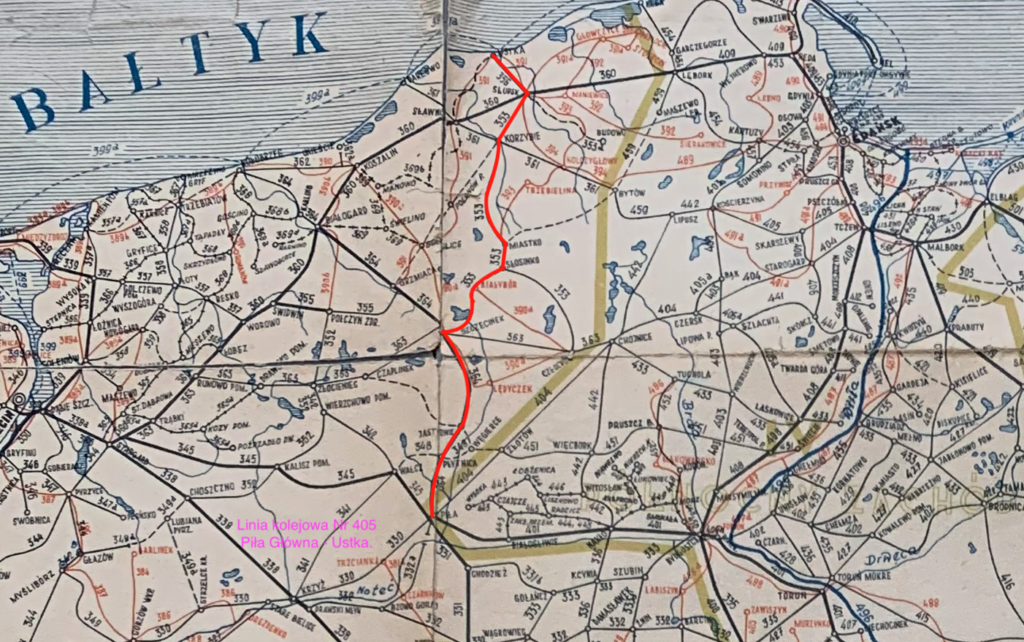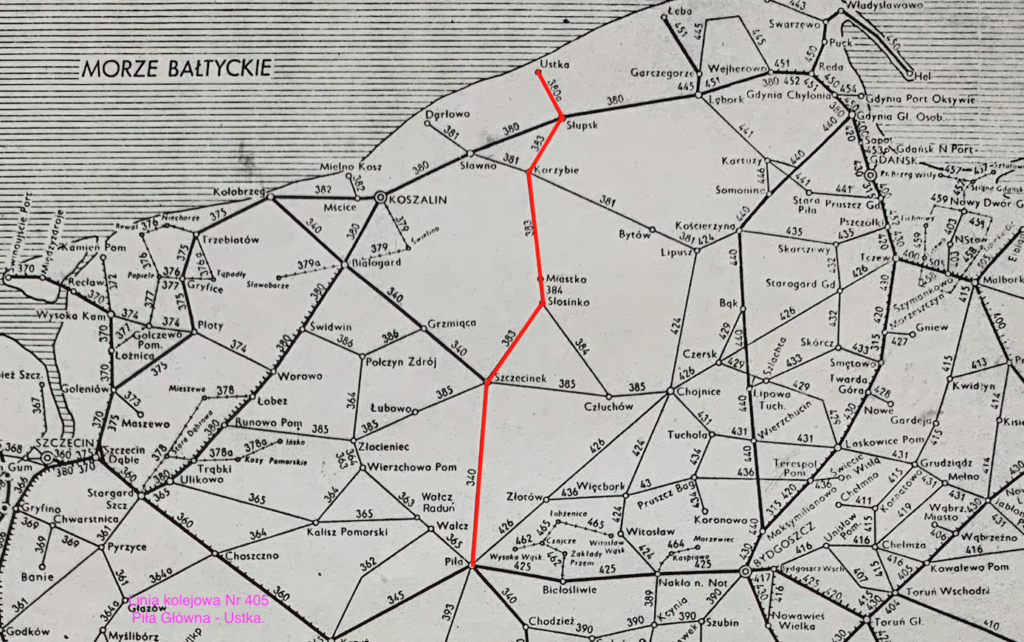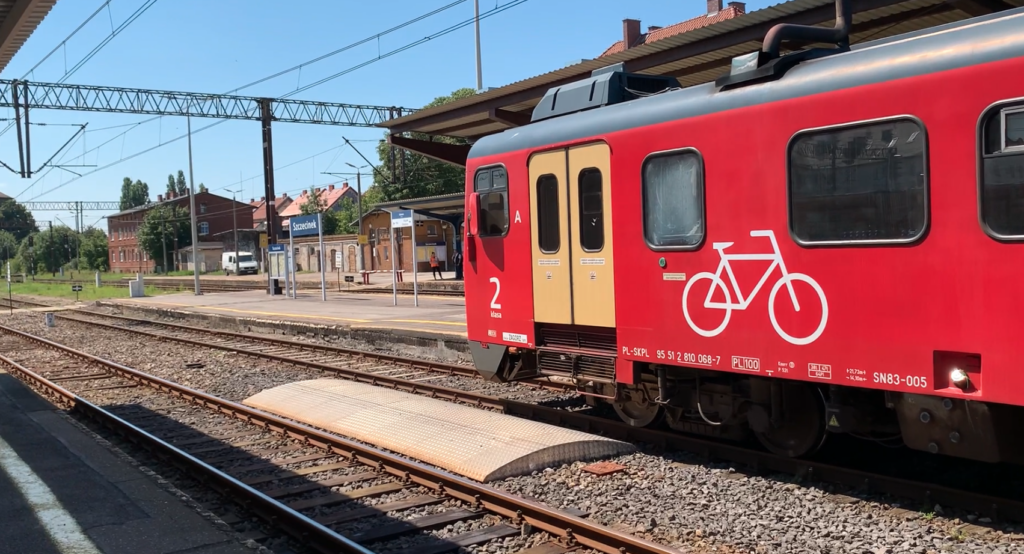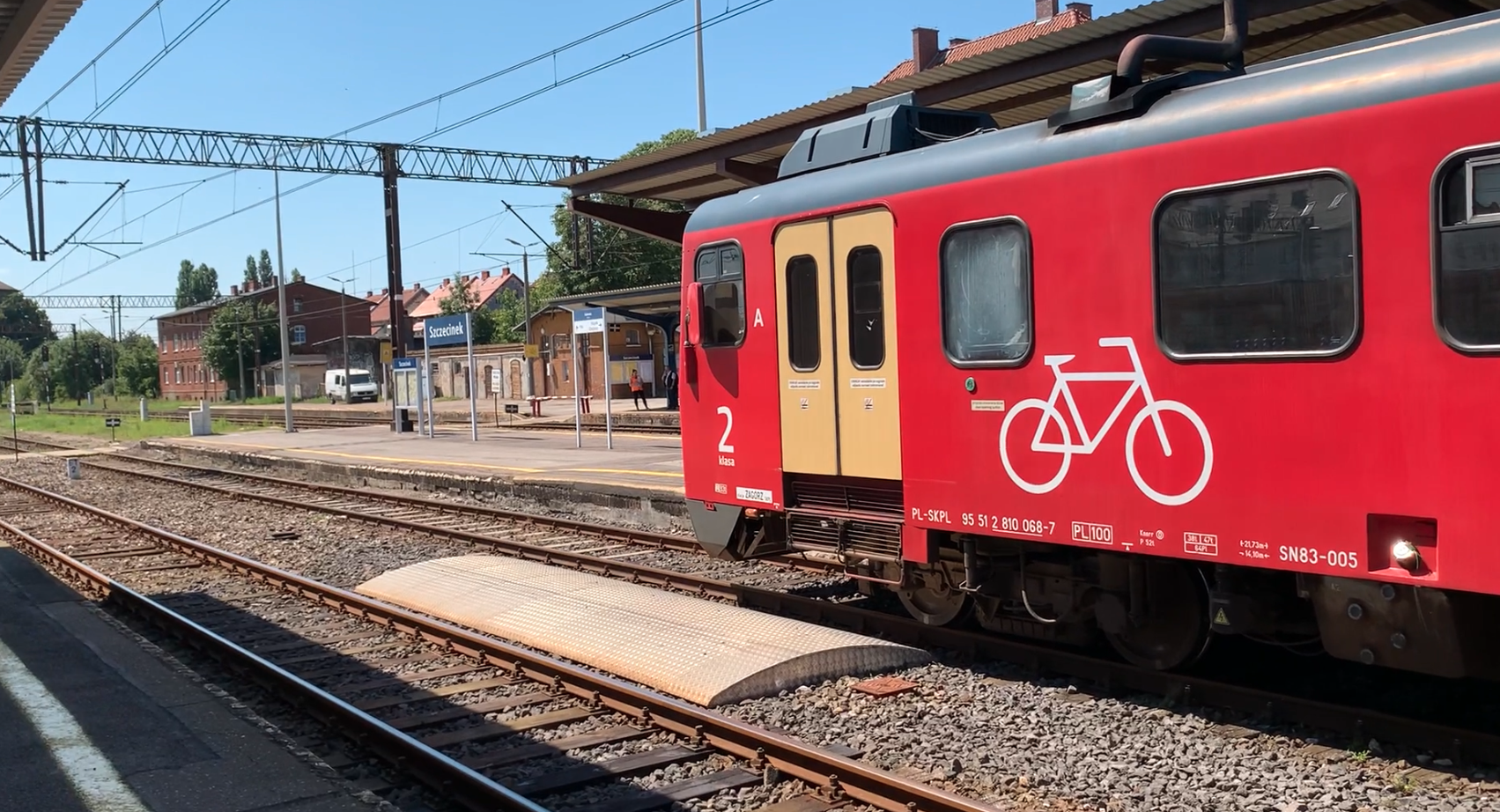Szczecinek 22-08-2024
Railway line No. 405 Piła Główna – Ustka.
Railway line No. 405 Piła Główna – Ustka is a single-track line, partially electrified, with a length of 193.419 km. The traction network is on the sections Piła Główna – Szczecinek and Słupsk – Ustka Uroczysko. The line runs from Piła Główna north to the town of Ustka (Ustka Uroczysko), then there is a military railway siding. The line runs through the provinces: Wielkopolskie, Zachodniopomorskie and Pomorskie. The train speed is 120 km/h. The line is equipped with the SHP system.



The railway line was built in stages. On May 15, 1879, the Piła Główna – Piła Północ – Szczecinek section was opened. On October 1, 1878, the Szczecinek – Ustka section was opened. After 1890, the Ustka – Ustka Uroczysko – Sławno side section was launched, to LK No. 202.
On December 30, 1989, the Piła Główna – Szczecinek section was electrified, and on December 18, 1990, the Słupsk – Ustka section. On December 15, 2019, the Ustka – Ustka Uroczysko section was electrified. The remaining section of the Szczecinek – Słupsk line remains unelectrified and there are no plans for electrification.
In 2019, the Słupsk – Ustka section was renovated, which allowed for the restoration of year-round passenger traffic on this section. InterCity class trains returned to the route. The timetable does not include a connection that would cover the entire length of LK No. 405. Long-distance trains bypass the non-electrified Szczecinek – Słupsk section, using LK No. 404 Szczecinek – Białogard and LK No. 202 Białogard – Słupsk. The last long-distance, express train on the Słupsk – Szczecinek section ran in 2000 and it was a seasonal train on the Słupsk – Wrocław route, pulled to Piła by an HCP SU46 locomotive.
In June 2020, renovation works were completed on the Szczecinek – Słupsk section. In January 2020, passenger lifts were launched at Miastko station. Trains had to slow down before some rail-road crossings because not all devices were running. Work on LK No. 405 was completed at the end of 2020. Work continued in the telecommunications industry, supplementing small architecture on platforms, including shelters, signage, waste bins, benches, information boards, clocks. As part of the work, 19 stations and stops were modernized. By June 2020, the Local Control Center Miastko and Słupsk was launched, as well as the Kawcze, Kępice, Słonowice and Charnowo Słupskie passing loops. Trains can “cross” at the Miastko and Słupsk stations and at the Biały Bór passing loop. After all the works were completed, trains were running at a speed of up to 100 km/h on almost the entire line, which shortened the travel time from Szczecinek to Słupsk by about 12 minutes.
The route of the No. 405 Piła Główna – Ustka railway line.
The No. 405 railway line starts at the Piła Główna station and runs parallel to the No. 203 railway line in its initial section. At the height of the goods station and the former buildings of the Piła Rolling Stock Repair Plants, it takes a wide arc to the north, viaducting the No. 203 tracks, to the Piła Północ branch station (3.833 km). This is where the No. 403 railway line branches off from it to Ulikowo. This is also where the No. 999 railway line from the Piła Towarowa station ends. The line bypasses the Piła Airport in a wide arc, passing through the town of Gładyszewo. Then the line runs through forests and crosses the National Road No. 10 at a road and rail junction. Next is the Stara Łubianka passenger stop (14.090 km). The trail continues through forests, crossing local roads, the Piłowa River and the Rurzyca River. Before the Płytnica station, the old track of the former Wałcz-Złotów railway line joins from the west. Here is the Płytnica railway station (21.790 km). Behind the station, the old track branches off eastwards to Złotów. The line crosses the Płytnica River once again. National Road No. 11 joins the railway line from the east. There is the Ptusza station (29.860 km). Behind the DK No. 11 station, it crosses the railway line at a rail-road crossing. Jastrowie station (34.835 km). Here are the railway sidings to the plants; Fuel Base No. 8 and Precon Polska Production Plant. In the town of Jastrowie, DK No. 11, 22 passes under the railway viaduct. On the other hand, there is a rail-road intersection with Kilinszczaków Street. The landscape changes from forest to agriculture. Then there is the Okonek station (48.074 km) and the bridge over the Czarna River. Then there is the Brokęcino passenger stop (53.370 km) and Lotyń station (58.270 km). Then there is the Turowo Pomorskie station (64.750 km).
We reach Szczecinek (70.711 km). Before the station from the west, line No. 405 is joined by railway line No. 210 from the side of Czaplinek (Runowo Pomorskie). Three lines leave Szczecinek station; To the north-west to the towns of Białogard and Kołobrzeg (LK No. 404). To the east, LK No. 210 to Chojnice. To the north, our LK No. 405 to Słupsk – Ustka. After World War II, the Szczecinek – Miastko section was impassable. Line No. 405 runs under the S11 road and is still single-track. In addition, a non-electrified section has begun. Initially, it runs through wastelands and fields, before entering the forests again. It crosses the Gwda River, provincial road No. 201. Then there is the Gwda Mała station (80.140 km). It crosses the Gnilec River. Drzonowo passenger stop (89.110 km). In the town of Jeziernik it crosses the Biała River. There is one of the few road viaducts above the tracks. In the town of Biały Bór there is a railway-road intersection along DK No. 25. There is a station Biały Bór (98.328 km). Then there is the station Słosinko (108.725 km). In the past the Stosinko-Przechlewo-Człuchów line branched off here. The line changes its main direction many times, bypassing numerous lakes. The line reaches the town of Miastko (115.729 km). In the past the Miastko-Bytów line was here. From the town of Miastko the line runs through forests. The line crosses DW No. 206, which accompanies the railway for a long section. Then there is Kwacze station (126.013 km), Przytocko stop (132.066 km), Ciecholub stop (138.360 km), Biesowice stop (140.676 km), Kępka stop (143.300 km). The line is accompanied by the Wieprza River. Next is Kępice station (146.153 km) and the line crosses the viaduct DW No. 208. Then the line crosses the Wieprza River. Next is Korzybie station (152.558 km) and the DW No. 209 rail-road crossing. At Korzybie station there were formerly railway lines; Korzybie – Sławno, Korzybie – Bytów and Korzybie – Polanów. Wrzącą Pomorska stop (158.853 km). Słonowice railway station (163.350 km). Agricultural areas began. Widzino stop (169.010 km). The line crosses the S6 (E28) road viaduct. Kobylina Słupska stop (171.370 km). Here, from the north, comes the LK from the direction of Koszalin – Sławno, which is electrified.
Słupsk station (175.004 km) is currently undergoing major reconstruction. Two electrified railway lines run from Słupsk station; towards Lębork (east) and to Ustka (north-west). There used to be a line north to Cegielnia, which had several other branches, as well as a second connection with Ustka station. LK No. 405 passes the Słupsk Północny stop (176.878 km), Strzelinko stop (181.890 km), Gałęzinowo stop (183.680 km), Charnowo Słupskie stations (185.410 km), a railway bridge over the Słupia river, and reaches Ustka. Ustka station (192.250 km), and above the tracks of DK No. 21. The station used to be a junction. The line after the station passes the Słupia River again, turns west and ends at the Ustka Uroczysko stop (193.283 km). Further on there is a railway siding to the military unit. In the past there was a further route to the town of Sławno.
Written by Karol Placha Hetman

Leave a Reply
You must be logged in to post a comment.